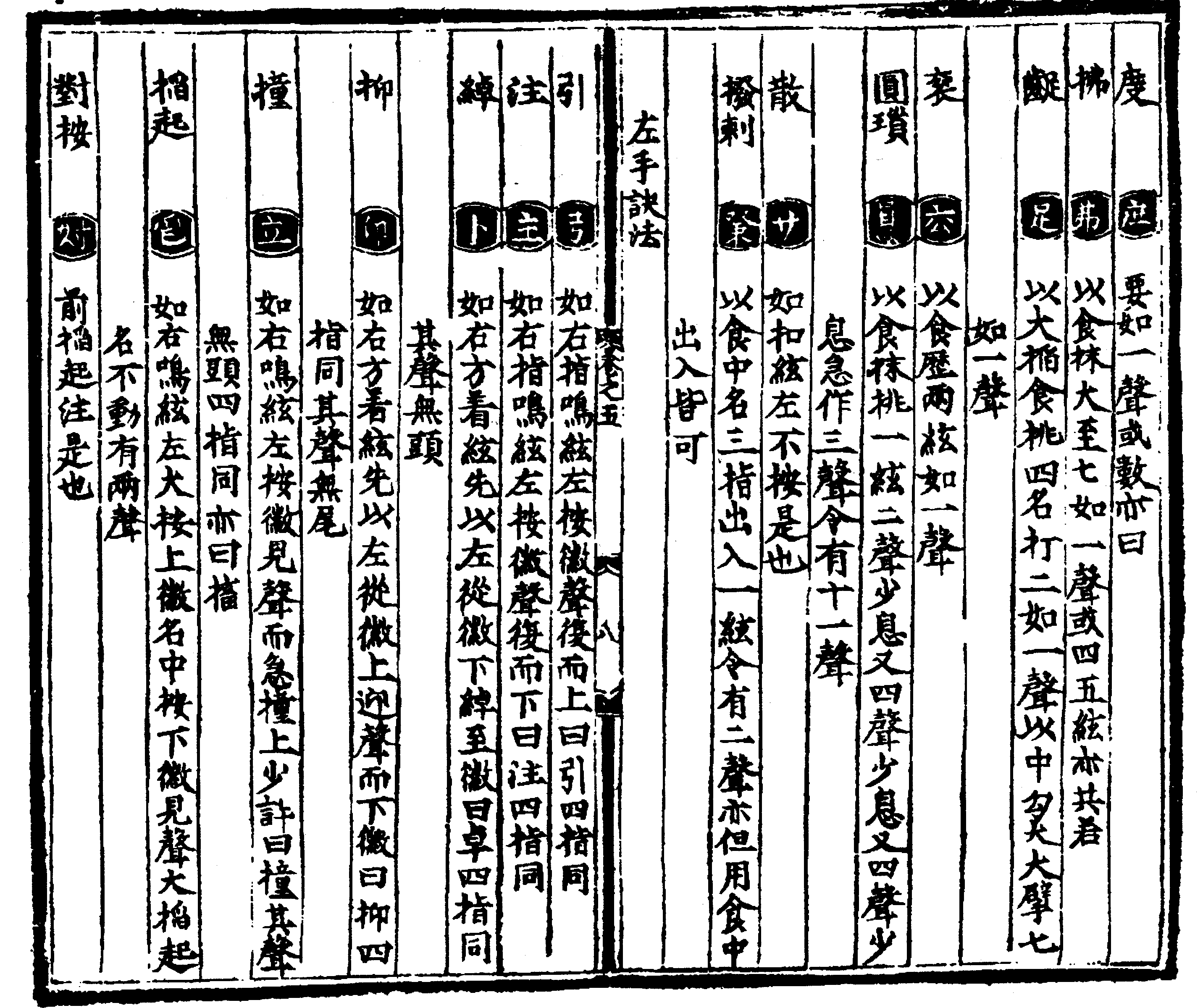|
T of C
Home |
My Work |
Hand- books |
Qin as Object |
Qin in Art |
Poetry / Song |
Hear, Watch |
Play Qin |
Analysis | History |
Ideo- logy |
Miscel- lanea |
More Info |
Personal | email me search me |
| Taiyin Daquanji ToC Folio 4 ToC / Folio 5 ToC parts 1 / 2&3 / 4 / 5&6 / 7 / 8 / 9&10 / "Folio 6": ToC | 網站目錄 |
| Taiyin Daquanji 1 | 太音大全集 |
| Folio 5, Part 8: Tablature explanations by Master Chen (Chen Kangshi? 2) | 卷五,八:唐陳居士聽聲數,應指法,并注譜絕 |
| (In the original the following sections and quotations are unnumbered..3) | QQJC I/91b - 93a |
| 陳居士 Master Chen's tablature explanations (QQJC I/91 bottom) | (This web page begins with the 9th column from the right of this image 4) |

This section begins with the statement
Chen Jushi (Chen the scholar? hermit? lay Buddhist?) listened to many sounds along with their corresponding fingering techniques (or "and responded by devising"); the tablature method he then described was subsequently "jue" (this could mean either "lost" or "cut off all the competition").
It then continues with fingering explanations. First comes the name of the technique, This is followed by the shorthand tablature version, inside the red circles at right but represented below by underlines if they cannot be written by computer: "___" (or if possible separate elements might be substituted). After this is the explanation of the technique, usually represented below by "....", as very few have been copied or translated here. There may be a link to a translation or other related details elsewhere.
- 單蠲 dan juan ___
以食中蠲一絃,先食抹,後中勾,急發令有三聲,亦名半蠲。.- 全扶 quan fu ___
以食抹兩絃,如一聲。- 曡蠲 die juan ___
以食指先抹大,少息,次抹二,急以中指勾大二,令有四聲,亦名連蠲。(大-一絃)- 半扶 ban fu ___
以食抹七,中勾六,如一聲。- 圓婁 yuan lou 婁 inside 囗
以食抹六,少息,有抹七,,以中勾五,令五七如一聲。- 背蠲 bei juan (This is at the beginning of QQJC I/92 top)
以中勾大又踢。大急以食抹,大令有四聲。
- 小璅 xiao suo 小巛
....- 短璅 duan suo 矢巛
....- 大璅 da suo 大巛
....- 長璅 chang suo
....- 換指璅 huanzhi suo
....- 背璅 bei suo 北巛
....- 打圓 da yuan 丁 inside 囗 (圓 written with 貟)
....- 小間勾 xiao jian gou
....- 大間勾 da jian gou
....
- 雙打 shuang da
....- 覆打 fu da
....- 輪 lun
....- 疊指 die zhi
....- 彈 tan
....- 雙彈 shuang tan
....- 歴 li 厂(歷)
....- 雙歷 shuang li(歷)
....- 度 du
....- 拂 fu 弗
....- 蹴 cu 足(蹵)
Explanation seems garbled; compare You Lan, where it seems to a left hand slide.
- 袞 gun
....- 圓璅 yuan suo 圓巛(圓 written with 貟)
.... (Why not grouped with 小璅 xiao suo etc?)- 散 san
Later grouped under left hand, but means don't use left hand- 撥剌 bo la (compare 潑刺 po ci )
....- 引 yin 弓
....- 注 zhu 主
....- 綽 chuo 卜
....- 迎 ying 卬
....- 撞 zhuang 立
....
- 搯起 tao qi
....- 對按 dui an
....- 罨 yan 电
....- 虛罨起 xu yan qi
....- 虛點起 xu dian qi
....- 念起 nian qi
....- 推出 tui chu 隹山
....- 猱 nao 犭
....- 吟 yin
....
- 不動 bu dong
....- 就 jiu 尤
....- 復上下 fu shang xia 复
....- 泛 fan 丿
....- 泛止 fan zhi 正
....- 按 an 女
....- 少息 shao xi 省
....- 從頭 cong tou 从豆
....- 從勾 cong gou 从勹
....- 從圏 cong juan 从口
.... - 全扶 quan fu ___
Return to the Folio 5 ToC.
Footnotes (Shorthand references are explained on a
separate page)
| 1. 太音大全集卷五 Taiyin Daquanji Folio 5, Part 8 | QQJC I/91, bottom: comments above begin at 8th column from left |
 See comments with right hand technique explanations.
See comments with right hand technique explanations.
Note also that these explanations are not at all complete. For example, ones that I have not yet found in this handbook include:
There are explanations for these in later handbooks but I am not sure if this means they are relatively later techniques.
2.
Master Chen's tablature explanations
3.
Explanations by translator
(Return)
"Master Chen" is said to be a reference to 陳康士
Chen Kangshi which, it is said, would date him to the 9th century CE. The Chinese name/title here actually calls him 陳居士 Chen Jushi, Jushi having many possible meanings include scholar, hermit, honorable person, commoner, lay person, lay Buddhist and so forth. The introduction goes on to say his fingering explanations are all lost, so it remains unclear who he really was.
(Return)
See comments concerning the structure of the original text.
(Return)
| QQJC I/92, top: comments correspond to #6 to #23 above |

4.
Images: Taigu Yiyin
Images from this Taigu Yiyin are easier to follow than the same material from Qinqu Jicheng, at right.
(Return)
| QQJC I/92, bottom: comments correspond to #24 to #37 above |

| QQJC I/93, top: comments correspond to #38 to #54 above |

Return to Taiyin Daquanji ToC